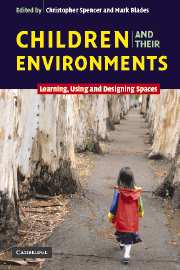Crossref Citations
This Book has been
cited by the following publications. This list is generated based on data provided by Crossref.
Read, Marilyn A.
2007.
Sense of Place in Child Care Environments.
Early Childhood Education Journal,
Vol. 34,
Issue. 6,
p.
387.
Kraftl, Peter
2008.
Environment for children: passive lessons from the everyday environment.
Children's Geographies,
Vol. 6,
Issue. 1,
p.
109.
Taylor, Chris
2009.
Towards a geography of education.
Oxford Review of Education,
Vol. 35,
Issue. 5,
p.
651.
Watson, Georgia Butina
2009.
Viewpoint:
Young people and the built environment: can they shape our cities?
.
Town Planning Review,
Vol. 80,
Issue. 3,
Nordström, Maria
2010.
Children’s Views on Child-friendly Environments in Different Geographical, Cultural and Social Neighbourhoods.
Urban Studies,
Vol. 47,
Issue. 3,
p.
514.
Catling, Simon
2010.
Sources of evidence for conducting research in geography education.
International Research in Geographical and Environmental Education,
Vol. 19,
Issue. 2,
p.
97.
Moser, Thomas
and
Martinsen, Marianne T.
2010.
The outdoor environment in Norwegian kindergartens as pedagogical space for toddlers' play, learning and development.
European Early Childhood Education Research Journal,
Vol. 18,
Issue. 4,
p.
457.
Melhuish, Clare
2011.
Re-Shaping Learning: A Critical Reader.
p.
19.
Murtagh, Brendan
and
Murphy, Aisling
2011.
Environmental Affordances and Children in Post-conflict Belfast.
Space and Polity,
Vol. 15,
Issue. 1,
p.
65.
McLaren, Coralee
Edwards, Geoffrey
Ruddick, Susan
Zabjek, Karl
and
McKeever, Patricia
2011.
Kindergarten kids in motion: Rethinking inclusive classrooms for optimal learning.
Educational and Child Psychology,
Vol. 28,
Issue. 1,
p.
100.
Mackintosh, Kelly A
Knowles, Zoe R
Ridgers, Nicola D
and
Fairclough, Stuart J
2011.
Using formative research to develop CHANGE!: a curriculum-based physical activity promoting intervention.
BMC Public Health,
Vol. 11,
Issue. 1,
Leverett, Stephen
2011.
Children and Young People’s Spaces.
p.
9.
Pike, Susan
2011.
“If you went out it would stick”: Irish children's learning in their local environments.
International Research in Geographical and Environmental Education,
Vol. 20,
Issue. 2,
p.
139.
Løkken, Gunvor
and
Moser, Thomas
2012.
Space and materiality in early childhood pedagogy – introductory notes.
Education Inquiry,
Vol. 3,
Issue. 3,
p.
303.
Brussoni, Mariana
Olsen, Lise L.
Pike, Ian
and
Sleet, David A.
2012.
Risky Play and Children’s Safety: Balancing Priorities for Optimal Child Development.
International Journal of Environmental Research and Public Health,
Vol. 9,
Issue. 9,
p.
3134.
Ata, Seda
Deniz, Aysegul
and
Akman, Berrin
2012.
The Physical Environment Factors in Preschools in Terms of Environmental Psychology: A Review.
Procedia - Social and Behavioral Sciences,
Vol. 46,
Issue. ,
p.
2034.
Coralee McLaren
Susan Ruddick
Geoffrey Edwards
Karl Zabjek
and
Patricia McKeever
2012.
Children's Movement in an Integrated Kindergarten Classroom: Design, Methods and Preliminary Findings.
Children, Youth and Environments,
Vol. 22,
Issue. 1,
p.
145.
Catling, Simon
2013.
Teachers' perspectives on curriculum making in Primary Geography in England.
The Curriculum Journal,
Vol. 24,
Issue. 3,
p.
427.
King, Gillian
Rigby, Patty
and
Batorowicz, Beata
2013.
Conceptualizing participation in context for children and youth with disabilities: an activity setting perspective.
Disability and Rehabilitation,
Vol. 35,
Issue. 18,
p.
1578.
Koller, Donna
and
McLaren, Coralee
2014.
Children's Emotional Responses to a Paediatric Hospital Atrium.
Children & Society,
Vol. 28,
Issue. 6,
p.
451.





